I actually don’t really have to explain there are issues with the silo structure in our organizations. Whenever I raise the topic to someone, or discuss it during one of my courses, people raise their eyebrows and sigh ‘Oh, I know!’ But even so, let me give you at least one. During the financial crisis of 2008 banks got a bad reputation for being ruthless money-grubbers that took unacceptable risks. While I am not arguing whether they deserve that rep, this is actually not the cause of the financial crisis. Official investigators concluded it was actually the organizational complexity caused by the silo structure of many banks that caused nobody to have oversight of what was really going on. Not even top management. Yes, some parts of the organizations took risky actions. But the silo structure concealed the actual consequences of local actions for everyone, even the ones that took them.
What I do find fascinating is why most large organizations seem to be unwilling or unable to change the silo structure. Whatever the reasons, in this article we will explore some ways to dampen the negative effects of silos, and provide some ways to break them down once and for all. While I hope many companies will start working on the latter, I am already satisfied if they start working on the first.
What can you expect from this article?
- What is the problem with silos in our organizations?
- How can we dampen the effects of silos without removing them?
- How can we solve the issues by removing the silos?
The curse of the silos
There are many issues associated with the silo structure. For details I refer to the Curse of the silos series. But here’s a list to summarize the major issues:
silos lead to myopia
The walls between the silos make it hard for anyone to have an overview of the entire organization. Even for top management. This increases risks significantly because the effects of a local decision on another part of the organization often goes unnoticed.
Silos lead to a culture of blaming
‘Don’t blame the people, blame the system’ is a saying derived from Systems Thinking. When something goes wrong in the organization, it is always somebody else’s fault. We have a deeply entrenched need to blame someone. Many times however it is the way we organized the system that is to blame. You can’t really blame a salesperson to go for a quick sale even it bring the department that has to follow up in trouble when sales is held accountable for a sales related target only. Silos with local KPIs lead to this kinf of behavior.
Silos lead to longer lead times
Silos increase the delays, and therefore lead times, because each silo optimizes their part in the value flow at the expense of others.
Silos limit success
Every growth engine has its limits build in already. We can overcome these limits before they manifest themselves. Unfortunately, the silo structure get in the way because the limiting factors can be in a different silo than the one the growth action originated from. For example, sales might initiate an action that enables sustainable growth, but that same action might in time expose a limit in the operations department that will eventually limit the growth. Because of the silo structure we tend to miss the connection between the two.
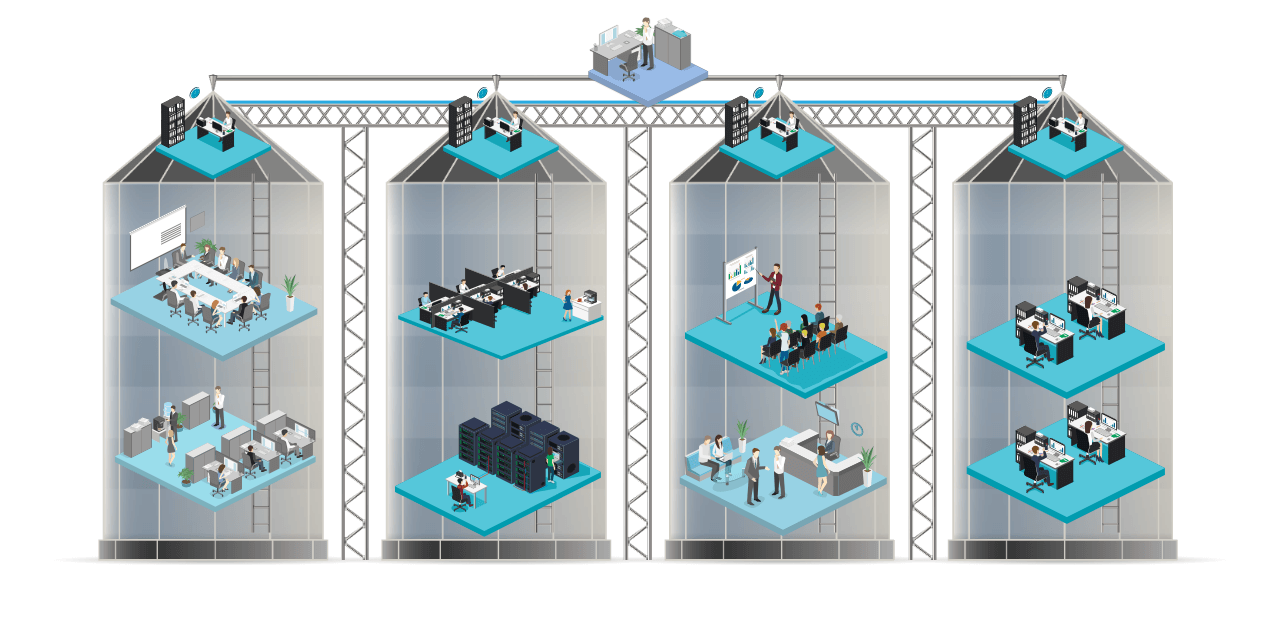
Curse of the silos
For a better understanding of the history and problems of the silo structure you can read the arcticles in the Curse of the silos series.
1. The silo culture hack
The simplest but still profound way of dampening the negative effects of the silos is to give people the KPI one level up in the hierarchy. The problem with most KPIs is it allows people to control meeting the targets even if it is at the expense of someone else. Moving targets one level up forces people/teams/departments to work together to meet the targets.
It is a culture hack because it doesn’t fundamentally solve the issue, but it does expose a flaw in the organization’s design. By exposing everyone to the dysfunction you might trigger a change in mindset which eventually allows for a structural solution. It is particularly powerful at the level of the executive committee. Because if the CFO is not merely responsible for the financial result, the CSO not only responsible for sales results, the CIO not just accountable for IT, then they just might become capable of being accountable for the results of the company as a whole first and their respective area second. And truly work together. What a message would that send towards the highly politicized decision-making that prevails in many organizations!
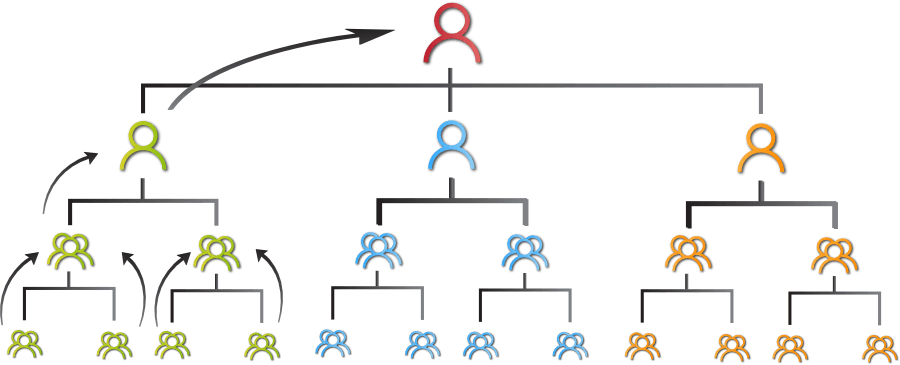
Culture hack: Move KPIs one level up
2. Define a unified purpose
The journey of identifying the organization’s purpose together can be a fraternizing matter on its own.
The power of a purpose – Building cathedrals
A traveler came upon a large work site in the center of a village. He had been traveling for many days, and he was eager to talk to anyone who would engage with him. He walked up to a worker at the site and asked, “Sir, may I ask what you are doing?” The worker scowled a bit and said tersely, “I am cutting stones.”
The traveler decided he would find little conversation there, so he moved on to another worker. When he asked the same question, the worker paused for a moment and explained that he was cutting stones so he could support his family. He had a wonderful wife and two small children who depended on him to provide them with food and shelter. They chatted about the project and the village for a few minutes, and the worker turned back to his large pile of stones.
The traveler moved to a third worker and asked the same question: “Sir, may I ask what you are doing?” The worker put down his tools, stood quite tall, looked the traveler in the eye and said with a warm smile, “I am building a cathedral! It will be the tallest and most magnificent structure for miles around. Its beauty will delight people for centuries to come. The stone I am now working on will go near the front door where people will enter for shelter and kinship. I will probably not see the final product, but I know my work is part of something very important.”

3. Organize cross-silo – baby steps
Most of the issues associated with silos have to do with not understanding the consequences of local actions across the silos. This is caused by the fact we optimize only the processes within our own silo; we measure only the results in our own silo; we set goals relating to work being executed in our silo only; and we keep communication within the boundaries of our own silo. Some steps you can take to counter the effects of the silos without actually removing them have to do with cross-silo organizing.
Leadership acting as a bridge
Some leaders feel comfortable maneuvering within the boundaries of their silo. Others have a wider curiosity. Find the latter. Find leaders who believe in the companies purpose as if it were their own and who realize it can only be achieved by working together. Incentivize them to broaden their network across the silos and act as bridges between departments. These ‘integrators’ can encourage someone with a local initiative to collaborate with the right people in other departments. The integrators job is to create doors and windows in the walls between silos and act as guides how to deal with other departments beyond the formal chain of authority.
Leadership as a bridge between silos
Cross-silo liaisons
A more formal approach is to provide liaisons who provide as a linking pin between departments. A liaison is department B’s representative in department A, responsible for improving communication and transparency between the two departments. Be sure to appoint people who neutral and nonjudgmental.
Note that the liaison is not supposed to have formal authority. He or she is not speaking in behalf of the department represented. Otherwise they will quickly become bottlenecks of communication and lose trust from the guest department. The liaison should not be a choking point of communication, nor a formal communication channel. He should facilitate people from different departments to just talk to each other instead of ignoring each other or resort to formal lines of authority.
Cross-silo liaisons
Build cross-silo capabilities
Skills and knowledge are fluid in a complex world. The skills we need today can quickly become obsolete tomorrow. We need people who feel comfortable gaining new skills all the time. Benefit from their mentality in stimulating cross silo capabilities. Even if people are specialized in the work of their own silo, they should be trained to know enough to effectively work together with other departments. If you understand the needs of someone who needs the outcome of your work as input you are less likely to optimize the work for your own benefit at the expense of your internal client.
Onboarding programs can play an important role in this by introducing people to all parts of the organization, instead of just their own department. It might even be a good idea to create cross-silo trainee groups. Job rotation programs are another way of building cross-silo capabilities.
Cross-silo capabilities
4. Organize in Value Streams – growing up
What is a value stream?
While the organization is vertically organized in silos, value flows horizontally across all involved silos/departments. Each department is responsible for a part of the total process that delivers an order or creates a product. They then hand it over to the next in line. It’s these hand-offs that are partly responsible for the delays and hence long lead times we experience in most organizations. It seems unnatural. Why did we design the organization in a way that lies across the way value flows towards our customers in the first place? The answer is that in a stable, predictable environment grouping people by function, which is the rationale behind silos, makes sense. They can learn from each-other more easily. It would still lead to local optimization but because the outcome of the processes as a whole are always the same it is easier to optimize them. In a volatile environment however, we need close collaboration by anyone involved in the process to get the results we want.
A value stream is all the activities and people involved in the process from idea or order capture to cash receipt. It’s like a virtual overlay on the silo structure depicting the flow of work, information, and communication across all who are involved in delivering value to the customer.
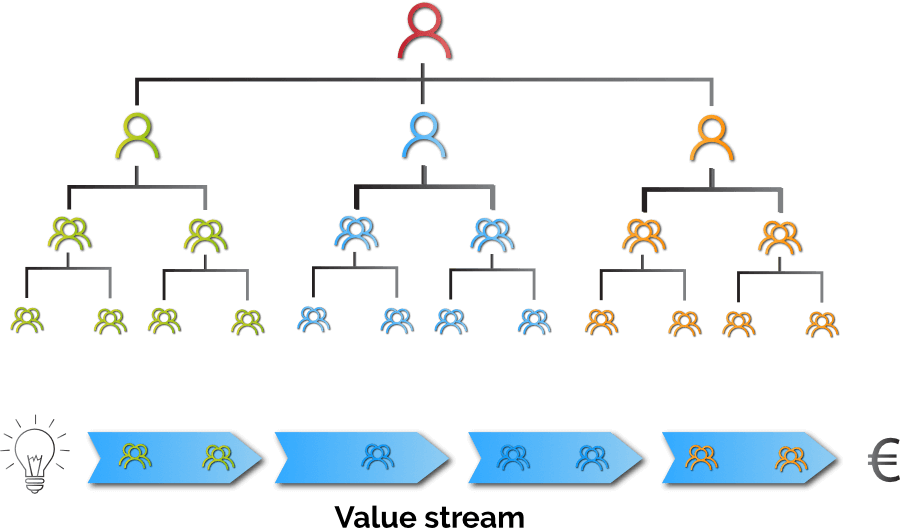
The concept of a value stream
SAFe
SAFe (Scaled Agile Framework) is a framework for scaling agile software development. Although SAFe also targets Systems engineering, hardware development, its roots and most of its examples lie in software development. An important artifact in SAFe is the value stream. SAFe recognizes the potential delays if people are collaborating effectively and seeks a way to group teams of teams in a way that minimizes lead times and maximizes the speed of learning.
SAFe’s concept of the value stream is applaudable and the popularity of the framework can certainly add to a transformation that reduces the issues with silos. There are two issues that prevents SAFe from being a breakthrough solution at the moment: The first is that SAFe makes a distinction between operational value streams and development value streams. The first are identified to be able to define the latter. Unfortunately, it is only the development value streams that SAFe supports in its framework. Development value streams contain the R&D work needed to support the operational value streams.
Copyright SAI Inc – www.scaledagileframework.com
Although it is possible to extend the use of the value stream concept in SAFe, this is a missed opportunity for SAFe. The second issue is that SAFe proposes virtual value streams. It’s a bit of a matrix format in which people work together in a horizontal value stream but still report into a vertical silo structure. Although starting this way is certainly easier, SAFe does little effort to stand up for a more permanent structure that dissolves many of the physical silos. Nevertheless, I have overheard practitioners dream of the day there would not be a separate IT and Sales department anymore because of the adoption of SAFe.
Virtual Value Streams
Structuring the organization according to the flow of value seems to make a lot of sense. Any other measure might contribute to dampening the negative effects of silos but the question remains if they are not only stop-gaps in the end.
Working in value streams, even if only virtual ones, has a lot of advantages. It becomes much easier to oversee the entire picture. People from several departments work together in a value stream on a common goal using common measures. This streamlines communication and collaboration, and it reduces waiting times because involved departments no longer optimize locally. It also stimulates supporting departments like facility management, legal, and procurement to help achieve actual business goals, because the involved employees have to achieve the common value stream goals first and the department goals second.
Organizing in value streams
The challenge of designing value streams
A challenge becomes the identification and design of the right value streams. In some organizations they can easily follow the lines of products and services. But it is not always that easy. Let’s take a bank for example who have product lines like loans, mortgages, etc. But the customer probably wants a unified view and experience across all services. So how dou you design the value streams? If a product has multiple customer segments, should you split the value stream along customer segment lines? If value streams have a lot of interdependencies, we create new problems. If a value stream does not have the authority to organize the work the way they deem fit for serving their customer’s purpose, for example because of mandatory centralized systems they lose some of the means and drive to be able meat their targets.
Busting the silos – organizing in psychical value streams
A disadvantage of virtual value streams is the addition of complexity in the organization design caused by the matrix structure. The silos are still there if you draw the org chart, but most members of the departments are long-term members of a value stream first. There are also practical issues like line managers still being responsible for an employee in terms of compensation and appraisals while he or she has hardly any authority over the work the employees does in the value stream.
Virtual value streams might allow a smoother transition towards psychical value streams. At some points the virtual value stream structure will start to ache and as long as you are transparent on this, this is a good thing. It will provide signals which practices to change first in a gradual move towards psychical value streams. Plus, it will tell when it becomes time to take off the training wheels and take the plunge. For some organizations it might be better to just rip off the band-aid and transition towards psychical value streams at once.
Challenges in psychical value streams
Many questions need to be answered when moving towards a value stream structure:
How much authority does each value stream get?
Ideally they can act as mini enterprises and be fully PL responsible. But does this mean they can refuse to use a central system for example?
What about budgeting?
Ideally you would budget the value stream confirming their independence and authority. This would for sure help depoliticize prioritization of initiatives because all former silo members in a value stream have the same goal.
How do we ensure cross-value stream knowledge sharing amongst people who share functional expertize?
After all, salespeople are now spread over different value streams, as are marketeers, developers, etc. One answer is virtual communities of interest in which people across value streams who share an interest, specialty, or domain get together to share knowledge, agree on best practices, etc.

FAVI, A METAL FOUNDRY PUTTING EMPLOYEES FIRST
The entire organization of Favi is split into 21 mini factories of 20 – 35 operators each. Some of them are support factories like laboratory and administration. Most are production units organized around either client, mostly automotive manufactures, or a products sector like water meters or rotors. The mini factories are almost completely self-sufficient, self-responsible, and self-organizing. A mini factory in characterized by their own geographical grouping of machines, their own floor and machines color, and sometimes even their own logo (that of the client).
Conclusion
Today’s organizational silo structure is one the big remains of the industrial revolution. And while it might have made sense back then, it doesn’t anymore. Silos stand in the way of the adaptiveness organizations need so badly in these times of high complexity and fast-paced change. This article discussed several ways to either dampen the effects of the silos or get rid of them once and for all. Getting there is not easy because it not only leads to a fundamental change in company structure, it also leads to a fundamental shift of mindset on matters like authorization and budgeting. But the rewards are great too: highly motivated aligned organizational units optimized to maximize the flow of value, fast decision-making, and fast learning.
Bibliography
List of notes and sources we reference from.
Notes
- Your content goes here.
- Edit or remove this text inline or in
- The module Content settings.
- You can also style every aspect of this content in the module
- Design settings and even apply custom
- CSS to this text in the module
- Advanced settings.
Follow this article
You can choose to follow this article in which case you will be notified when there there are updates of the article. You can also choose to follow all articles of this category. You will then be notified if a new article is added in this category.

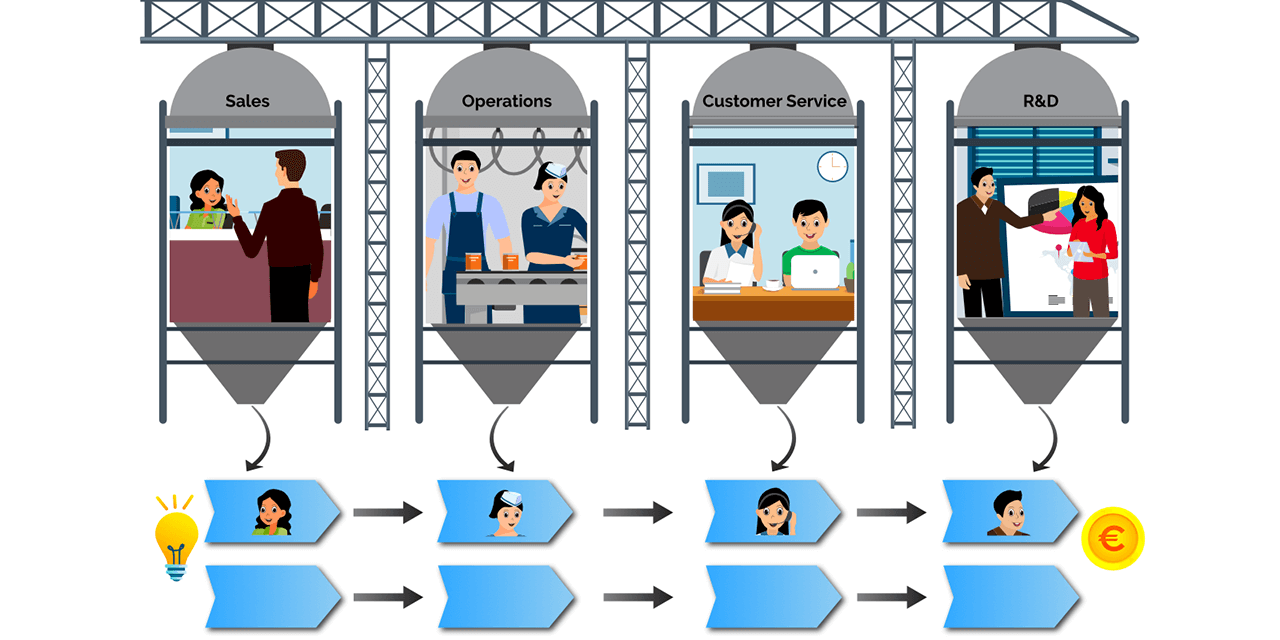
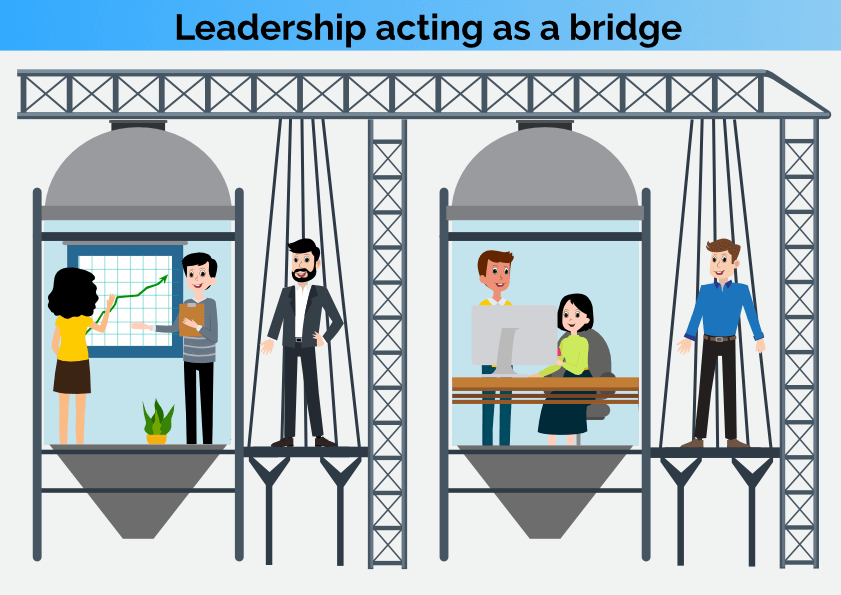
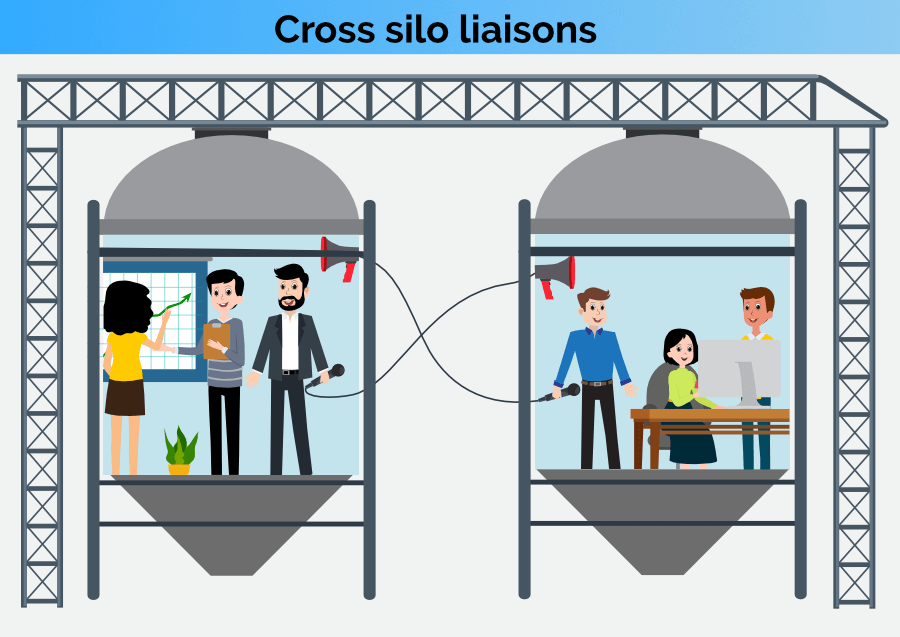
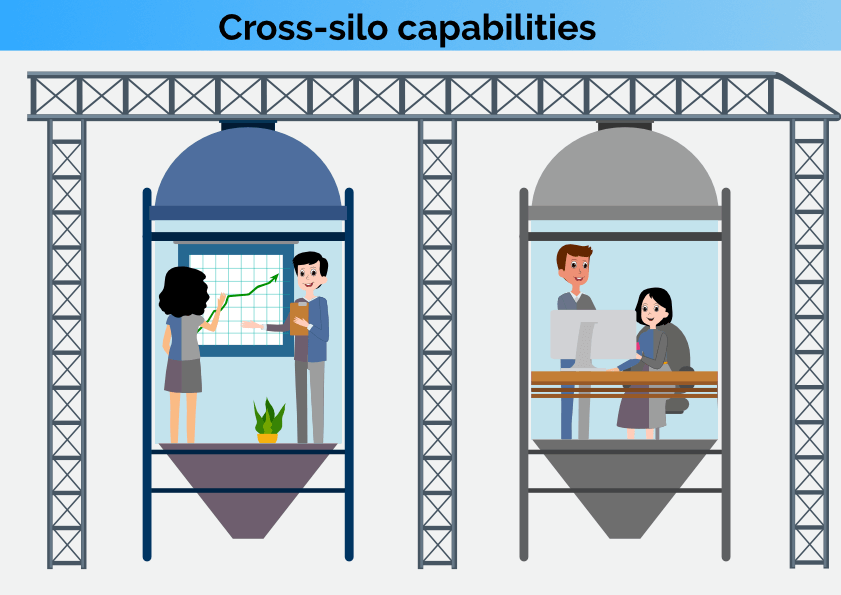
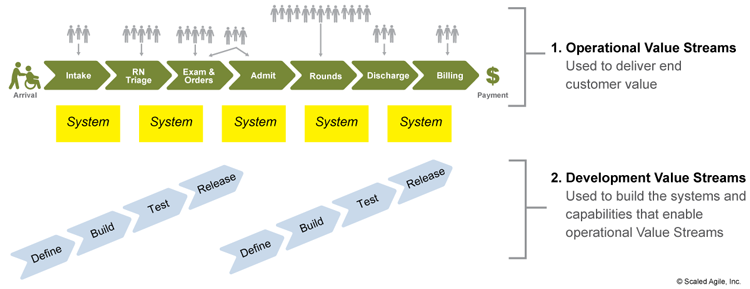

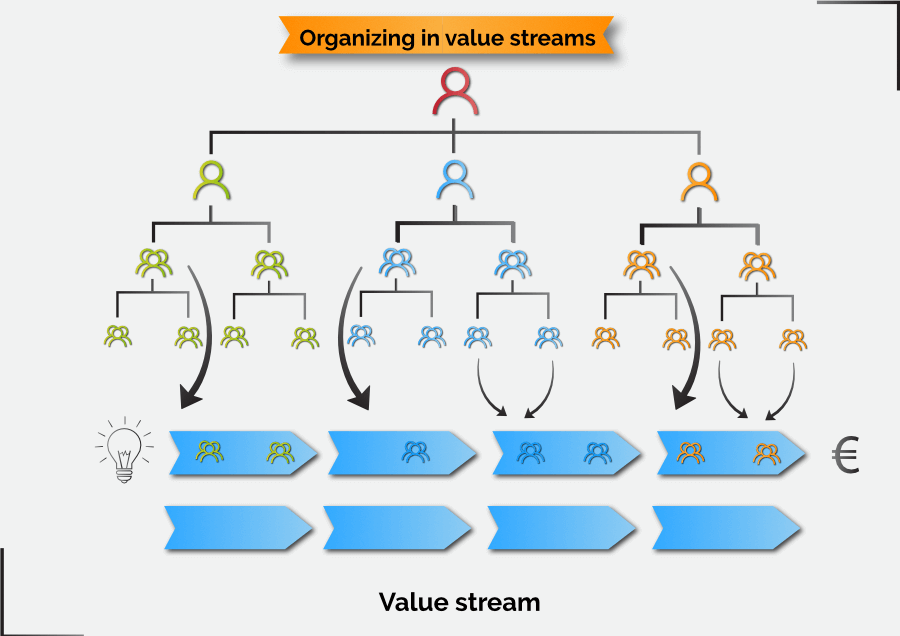



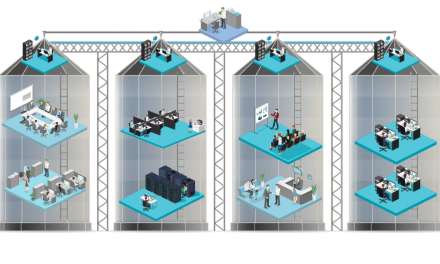
Trackbacks/Pingbacks